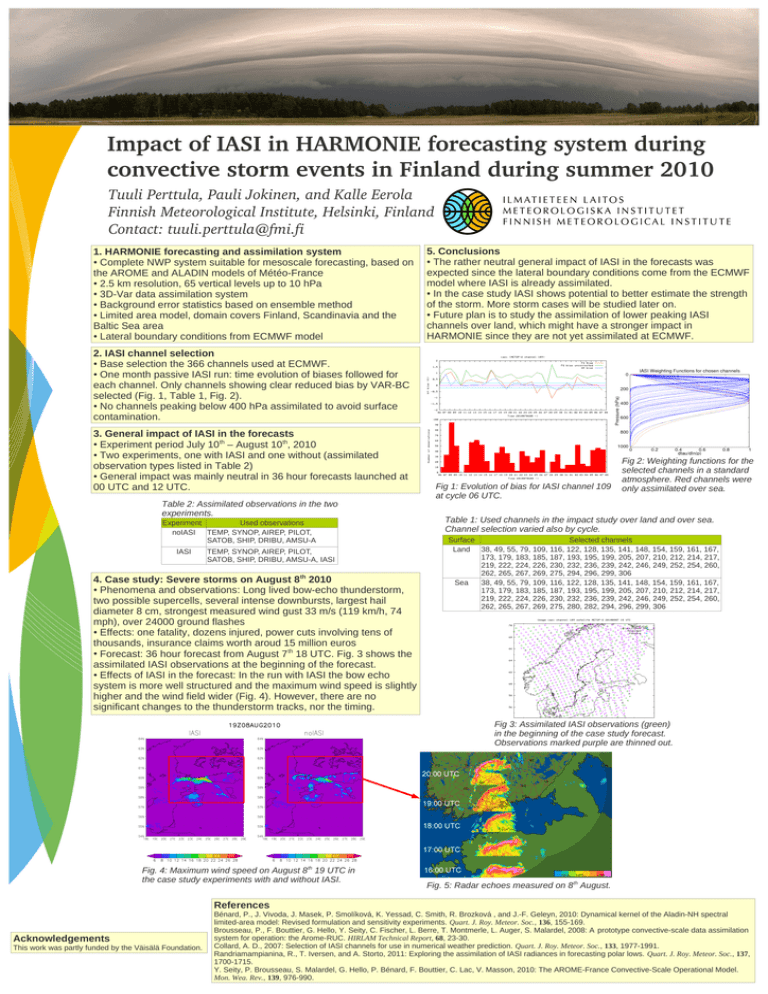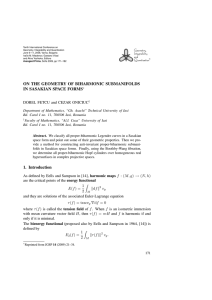Impact of IASI in HARMONIE forecasting system during convective storm events in Finland during summer 2010
advertisement

Impact of IASI in HARMONIE forecasting system during convective storm events in Finland during summer 2010 Tuuli Perttula, Pauli Jokinen, and Kalle Eerola Finnish Meteorological Institute, Helsinki, Finland Contact: tuuli.perttula@fmi.fi 1. HARMONIE forecasting and assimilation system ● Complete NWP system suitable for mesoscale forecasting, based on the AROME and ALADIN models of Météo-France ● 2.5 km resolution, 65 vertical levels up to 10 hPa ● 3D-Var data assimilation system ● Background error statistics based on ensemble method ● Limited area model, domain covers Finland, Scandinavia and the Baltic Sea area ● Lateral boundary conditions from ECMWF model 5. Conclusions ● The rather neutral general impact of IASI in the forecasts was expected since the lateral boundary conditions come from the ECMWF model where IASI is already assimilated. ● In the case study IASI shows potential to better estimate the strength of the storm. More storm cases will be studied later on. ● Future plan is to study the assimilation of lower peaking IASI channels over land, which might have a stronger impact in HARMONIE since they are not yet assimilated at ECMWF. 2. IASI channel selection ● Base selection the 366 channels used at ECMWF. ● One month passive IASI run: time evolution of biases followed for each channel. Only channels showing clear reduced bias by VAR-BC selected (Fig. 1, Table 1, Fig. 2). ● No channels peaking below 400 hPa assimilated to avoid surface contamination. 3. General impact of IASI in the forecasts ● Experiment period July 10th – August 10th, 2010 ● Two experiments, one with IASI and one without (assimilated observation types listed in Table 2) ● General impact was mainly neutral in 36 hour forecasts launched at 00 UTC and 12 UTC. Table 2: Assimilated observations in the two experiments. Experiment Used observations noIASI TEMP, SYNOP, AIREP, PILOT, SATOB, SHIP, DRIBU, AMSU-A IASI TEMP, SYNOP, AIREP, PILOT, SATOB, SHIP, DRIBU, AMSU-A, IASI 4. Case study: Severe storms on August 8 th 2010 ● Phenomena and observations: Long lived bow-echo thunderstorm, two possible supercells, several intense downbursts, largest hail diameter 8 cm, strongest measured wind gust 33 m/s (119 km/h, 74 mph), over 24000 ground flashes ● Effects: one fatality, dozens injured, power cuts involving tens of thousands, insurance claims worth aroud 15 million euros ● Forecast: 36 hour forecast from August 7 th 18 UTC. Fig. 3 shows the assimilated IASI observations at the beginning of the forecast. ● Effects of IASI in the forecast: In the run with IASI the bow echo system is more well structured and the maximum wind speed is slightly higher and the wind field wider (Fig. 4). However, there are no significant changes to the thunderstorm tracks, nor the timing. Fig 1: Evolution of bias for IASI channel 109 at cycle 06 UTC. Fig 2: Weighting functions for the selected channels in a standard atmosphere. Red channels were only assimilated over sea. Table 1: Used channels in the impact study over land and over sea. Channel selection varied also by cycle. Surface Selected channels Land 38, 49, 55, 79, 109, 116, 122, 128, 135, 141, 148, 154, 159, 161, 167, 173, 179, 183, 185, 187, 193, 195, 199, 205, 207, 210, 212, 214, 217, 219, 222, 224, 226, 230, 232, 236, 239, 242, 246, 249, 252, 254, 260, 262, 265, 267, 269, 275, 294, 296, 299, 306 Sea 38, 49, 55, 79, 109, 116, 122, 128, 135, 141, 148, 154, 159, 161, 167, 173, 179, 183, 185, 187, 193, 195, 199, 205, 207, 210, 212, 214, 217, 219, 222, 224, 226, 230, 232, 236, 239, 242, 246, 249, 252, 254, 260, 262, 265, 267, 269, 275, 280, 282, 294, 296, 299, 306 Fig 3: Assimilated IASI observations (green) in the beginning of the case study forecast. Observations marked purple are thinned out. Fig. 4: Maximum wind speed on August 8th 19 UTC in the case study experiments with and without IASI. Fig. 5: Radar echoes measured on 8th August. References Acknowledgements This work was partly funded by the Väisälä Foundation. Bénard, P., J. Vivoda, J. Masek, P. Smolíková, K. Yessad, C. Smith, R. Brozková , and J.-F. Geleyn, 2010: Dynamical kernel of the Aladin-NH spectral limited-area model: Revised formulation and sensitivity experiments. Quart. J. Roy. Meteor. Soc., 136, 155-169. Brousseau, P., F. Bouttier, G. Hello, Y. Seity, C. Fischer, L. Berre, T. Montmerle, L. Auger, S. Malardel, 2008: A prototype convective-scale data assimilation system for operation: the Arome-RUC. HIRLAM Technical Report, 68, 23-30. Collard, A. D., 2007: Selection of IASI channels for use in numerical weather prediction. Quart. J. Roy. Meteor. Soc., 133, 1977-1991. Randriamampianina, R., T. Iversen, and A. Storto, 2011: Exploring the assimilation of IASI radiances in forecasting polar lows. Quart. J. Roy. Meteor. Soc., 137, 1700-1715. Y. Seity, P. Brousseau, S. Malardel, G. Hello, P. Bénard, F. Bouttier, C. Lac, V. Masson, 2010: The AROME-France Convective-Scale Operational Model. Mon. Wea. Rev., 139, 976-990.

